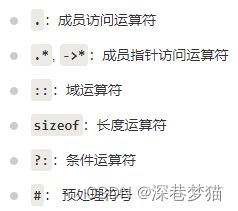C++冲鸭~【面向对象】
C++类和对象
类定义
使用关键字 class 定义 Box 数据类型,包含了三个成员变量 length、breadth 和 height:
class box{
public:
double length; // 盒子长
double breadth; // 盒子宽
double height; // 盒子高
};
对象定义
Box box1;
Box box2;
访问数据成员
示例:
#include 类成员函数
#include C++类访问修饰符【公有、私有、受保护】
public
#include private
【默认情况下,类的所有成员都是私有的,私有成员变量或函数在类的外部是不可访问的,甚至是不可查看的,只有类和友元函数可以访问私有成员】
class Box{
double width; // 默认私有
public:
double length;
void setWidth( double wid );
double getWidth( void );
};
#include protected
protected(受保护的)成员变量或函数与私有成员十分相似,但有一点不同,protected成员在派生类(子类)中是可访问的。
#include 继承中的特点:
有public,protected,private三种继承方式,他们对应地改变了基类成员的访问属性。
- public继承:基类public成员,protected成员,private成员的访问属性在派生类中分别变成:public,protected,private。
- protected继承:基类public成员,protected成员,private成员的访问属性在派生类中分别变成:protected,protected,private。
- private继承:基类public成员,protected成员,private成员的访问属性在派生类中分别变成:private,private,private。
但无论哪种继承方式,以下两点不变: - private成员只能被奔雷成员(类内)和友元访问,不能被派生类访问;
- protected成员可以被派生类访问。
public继承
#includeprotected继承
#includeprivate 继承
#includeC++类构造函数&析构函数
类的析构函数
类的构造函数是类的一种特殊的成员函数,它会在每次创建类的新对象时执行。
构造函数的名称与类的名称是完全相同的,并且不会返回任何类型,也不会返回 void。构造函数可用于为某些成员变量设置初始值。
#include 编译执行结果:
Object is being created
Length of line : 6
带参数的构造函数
默认的构造函数没有任何参数,但如果需要,构造函数也可以带有参数,这样在创建对象时就会给对象赋初始值。
#include 编译和执行结果:
Object is being created, length = 10
Length of line : 10
Length of line : 6
使用初始化列表来初始化字段
Line::Line( double len ): length(len){
cout << "Object is being created, length = " << len <<endl;
}
等价于
Line::Line( double len ){
length = len;
cout << "Object is being created, length = " << len <<endl;
}
假设有一个类C,具有多个字段XYZ等需要进行初始化,同理地,可以使用上面语法,只需要在不同的字段使用逗号进行分隔:
C::C( double a, double b, double c ): X(a), Y(b), Z(c){
...
}
类的析构函数
类的析构函数是类的一种特殊的成员函数,它会在每次删除所创建的对象时执行。
析构函数的名称与类的名称是完全相同的,只是在前面加了个波浪号(~)作为前缀,他不会返回任何值,也不能带有任何参数。析构函数有助于在跳出程序前释放资源。
#include 编译和执行结果:
Object is being created
Length of line : 6
Object is being deleted
C++拷贝构造函数
拷贝构造函数是一种特殊的构造函数,它是创建对象时,是使用同一类中之前创建的对象来初始化新创建的对象。
拷贝构造函数通常用于:
- 通过使用另一个同类型的对象来初始化新创建的对象;
- 复制对象把它作为参数传递给函数;
- 复制对象,并从函数返回这个对象。
如果在类中没有定义拷贝构造函数,编译器会自行定义一个。如果类带有指针变量,并从动态内存分配,则它必须有一个拷贝构造函数。拷贝构造函数的最常见形式如下:
classname (const classname &obj) {
// 构造函数的主体
}
//obj是一个对象引用,该对象是用于初始化另一个对象的。
实例:
#include 编译和执行结果:
调用构造函数
调用拷贝构造函数并为指针 ptr 分配内存
line 大小 : 10
释放内存
释放内存
通过使用已有的同类型的对象来初始化新创建的对象
#include 编译执行结果:
调用构造函数
调用拷贝构造函数并为指针 ptr 分配内存
调用拷贝构造函数并为指针 ptr 分配内存
line 大小 : 10
释放内存
调用拷贝构造函数并为指针 ptr 分配内存
line 大小 : 10
释放内存
释放内存
释放内存
C++友元函数
类的友元函数是定义在类外部,但有权访问类的所有私有(private)成员和保护(protected)成员。尽管友元函数的原型在类的定义中出现,但是友元函数不是成员函数。
友元可以是一个函数,该函数被称为友元函数;友元也可以是一个类,该类被称为友元类,在这种情况下,整个类及其所有成员都是友元。
如果要声明函数为一个类的友元,需要在类定义中该函数原型前使用关键字friend:
class Box{
double width;
public:
double length;
friend void printWidth( Box box );
void setWidth( double wid );
};
声明类ClassTwo的所有成员函数作为类ClassOne的友元,需要在类ClassOne的定义中前置如下声明:
friend class ClassTwo;
#include 编译执行结果:
Width of box : 10
C++内联函数【通过内联函数,编译器试图在调用函数的地方扩展函数体中的代码】
#include **内联函数inline:**引入内联函数的目的是为了解决程序中函数调用的效率问题,这么说吧,程序在编译器编译的时候,编译器将程序中出现的内联函数的调用表达式用内联函数的函数体进行替换,而对于其他的函数,都是在运行时候才被替代。这其实就是个空间代价换时间的节省。所以内联函数一般都是1-5行的小函数。在使用内联函数时要留神:
- 在内联函数内不允许使用循环语句和开关语句;
- 内联函数的定义必须出现在内联函数第一次调用之前;
- 类结构中所在的类说明内部定义的函数是内联函数。
C++中的this指针【每个对象都有一个特殊的指针this,指向对象本身】
C++中,this指针是一个特殊的指针,它指向当前对象的实例。
在C++中,每一个对象都能通过this指针来访问自己的地址。
友元函数没有this指针,因为友元不是类的成员,只有成员函数才有this指针。
#include C++中指向类的指针【指向类的指针方式如同指向结构的指针。实际上,类可以堪称是一个带有函数的结构】
#include C++类的静态成员【类的数据成员和函数成员都可以声明为静态的】
可以使用static关键字来把类成员定义为静态的。当我们声明类的成员为静态时,这意味这无论创建多少个类的对象,静态成员都只有一个副本。
#include 静态成员函数
静态成员函数即使在类对象不存在的情况下也能被调用,静态函数只要使用类名加范围解析运算符 :: 就可以访问。
静态成员函数与普通成员函数的区别:
- 静态成员函数没有this指针,只能访问静态成员(包括静态成员变量和静态成员函数);
- 普通成员函数有this指针,可以访问类中的任意成员;而静态成员函数没有this指针。
#include C++继承
基类和派生类
class Animal{
eat();
sleep();
};
class Dog : public Animal {
bark();
};
形式:class derived-class: access-specifier base-class
#include 访问控制和继承
派生类可以访问基类中所有的非私有成员。因此基类成员如果不想被派生类的成员函数访问,则应用在基类中声明为private。

继承类型
当一个类派生自基类,该基类可以被继承为public、protected或private几种类型。继承类型是通过上面讲解的访问修饰符access-specifier来指定的。
我们几乎不适用protected或private,通常使用public继承。
多继承
指一个子类可以有多个父类,它继承了多个父类的特性。
c++类可以从多个类继承成员:
class <派生类名>:<继承方式1><基类名1>,<继承方式2><基类名2>,…
{
<派生类类体>
};
实例:
#include C++重载运算符和重载函数
C++允许在同一作用域中的某个函数和运算符指定多个定义,分别称为函数重载和运算符重载。
重载声明是指一个与之前已经在该作用域内声明过的函数或方法具有相同名称的声明,但是他们的参数列表和定义(实现)不相同。
当调用一个重载函数或重载运算符时,编译器通过把所用的参数类型与定义中的参数类型进行比较,决定选用最合适的定义。选择最合适的重载函数或重载运算符的过程,称为重载决策。
函数重载
#include 运算符重载
#include 可重载的运算符/不可重载的运算符
C++多态
多态:各种形态。当类之间存在层次结构,并且类之间是通过继承关联时,就会用到多态。C++多态意味这调用成员函数时,会根据调用函数的对象的类型来执行不同的函数。
#include 每个子类都有一个函数area()的独立实现。多态可以有多个不同的类,都带有同一个名称但具有不同的实现函数,函数的参数甚至可以是相同的。
虚函数
虚函数是在基类中使用关键字virtual声明的函数。在派生类中重新定义基类中定义的虚函数时,会告诉编译器不要静态链接到该函数。动态链接或后期绑定
纯虚函数
在基类中定义虚函数,以便在派生类中重新定义该函数更好的适用于对象,但是基类中又不能对虚函数给出有意义的实现,这时就要用虚函数。
class Shape{
protected:
int width, height;
public:
Shape( int a=0, int b=0 ){
width = a;
height = b;
}
// pure virtual function
virtual int area() = 0;
};
C++数据抽象
数据抽象是指,只向外界提供关键信息,并隐藏其后台的实现细节,即可表现必要的信息而不呈现细节。
数据抽象是一种依赖于接口和实现分离的编程技术。
实例:
#include C++数据封装
C++程序有两个基本要素:程序语句(代码)和程序数据。
通常情况下,我们都会设置类成员状态为私有(private),除非我们真的需要将其暴露,这样才能保证良好的封装性。
这通常应用于数据成员,但它同样适用于所有成员,包括虚函数。
C++接口(抽象类)
接口描述了类的行为和功能,而不需要完成类的特定实现。
C++接口时使用抽象类来实现的,数据抽象是一个把实现细节与相关的数据分离开的概念。
如果类中至少有一个函数被声明为纯虚函数,则这个类就是抽象类。纯虚函数是通过在声明中使用 “=0” 来指定的,如下所示:
class Box{
public:
virtual double getVolume() = 0;
private:
double length;
double breadth;
double height;
};
设计抽象类的目的,是为了给其他类提供一个可以继承的适当的基类。抽象类不能被用于实例化对象,它只能作为接口使用。如果试图实例化一个抽象类的对象,会导致编译错误。
因此,如果一个 ABC 的子类需要被实例化,则必须实现每个纯虚函数,这也意味着 C++ 支持使用 ABC 声明接口。如果没有在派生类中重写纯虚函数,就尝试实例化该类的对象,会导致编译错误。
可用于实例化对象的类被称为具体类。
实例:
#include 设计策略
面向对象的系统可能会使用一个抽象基类为所有的外部应用程序提供一个适当的、通用的、标准化的接口。然后,派生类通过继承抽象基类,就把所有类似的操作都继承下来。
外部应用程序提供的功能(即公有函数)在抽象基类中是以纯虚函数的形式存在的。这些纯虚函数在相应的派生类中被实现。
这个架构也使得新的应用程序可以很容易地被添加到系统中,即使是在系统被定义之后依然可以如此。

